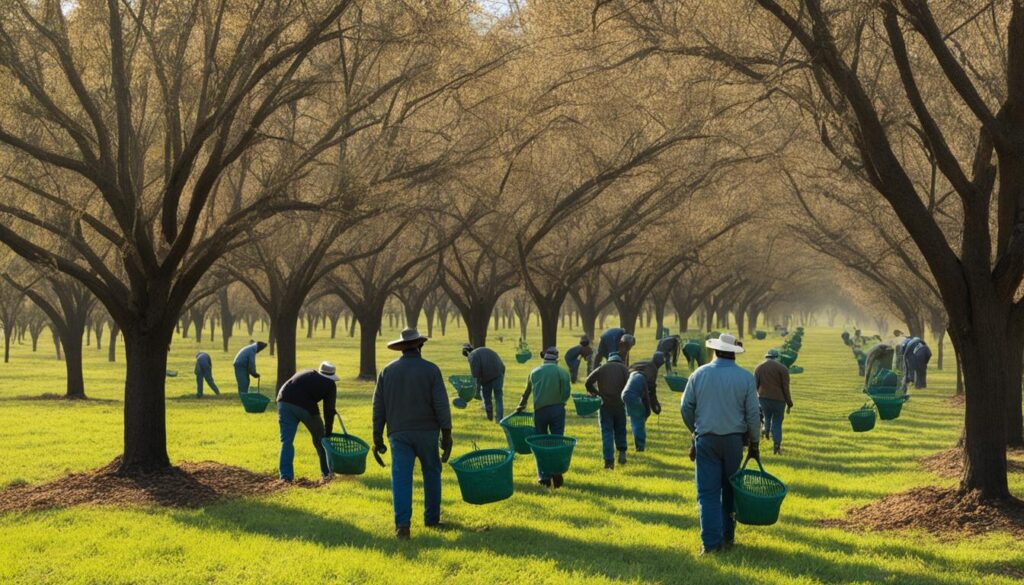Are you wondering when your pecan trees will start producing? The production of pecans can vary depending on several factors, such as propagation methods, varieties, and environmental conditions. Understanding the maturity rate of pecan trees is essential for planning and managing your pecan orchard successfully.
Pecan trees typically take anywhere from 2 to 10 years to start producing nuts. If you are growing pecans from seeds, it can take up to 20 years before you see a harvest. However, starting with seedlings or grafting can significantly reduce the waiting time to 4-6 years. Planting potted trees or bare roots can yield pecans in as early as four years, giving you a head start on enjoying the delicious nuts.
It’s important to note that pecan trees require time to develop a robust root system and mature enough to produce a significant crop. Patience and care are crucial during the early years of pecan tree growth.
By understanding the factors influencing pecan tree production and following proper care and maintenance practices, you can ensure a bountiful harvest of these tasty nuts for years to come.
The History and Harvesting of Pecan Trees
Pecan trees have a rich history in the Southern United States, being native to the region and considered an original North American heritage nut. Georgia is the leading pecan-producing state in the US, with Albany being known as the pecan capital of America.
Pecan trees can produce 200-250 pounds of pecans per year, but it takes 10-15 years for a healthy tree to reach this level of productivity. Patience is key when cultivating pecan trees, as they require time to establish strong roots and mature sufficiently to produce a significant crop.
Harvesting pecans has evolved over time with the introduction of specialized machines called “shakers.” These shakers are used to mechanically shake the nuts out of the trees, making the harvesting process more efficient and less labor-intensive. In fact, these machines can accomplish in an hour what used to take 25-30 people an entire day.
Proper harvesting techniques are crucial to ensure the quality of the pecan crop. Using sweepers to collect the nuts, for example, helps prevent damage and preserve the overall integrity of the harvested pecans.
By continually improving harvesting methods and adopting innovative technologies, pecan tree farmers can maximize the productivity and profitability of their orchards.
Tips and Guidelines for Pecan Tree Production
If you’re planning to grow pecan trees, following these guidelines will help ensure successful production. Pecans thrive best in alluvial (riverbed) soils that are deep and well-drained, although they can also be grown in any soil that allows for proper water penetration to a depth of at least four to five feet.
To promote healthy root development, it is crucial to prepare the soil correctly and ensure good drainage. This will provide the ideal conditions for pecan trees to establish and grow.
When it comes to tree training, allow the branches to grow initially, and then prune them to achieve the desired shape. This helps maintain the tree’s structure and allows for better light penetration, resulting in more consistent nut production.
Nitrogen and zinc are two key nutrients required for successful pecan tree production. For optimal results, apply nitrogen in the spring before bud break. Additionally, consider supplementing with zinc, particularly in arid regions where zinc deficiency could be an issue.
Leaf tissue samples can be beneficial in determining the nutrient status of pecan trees and guiding fertilizer applications. Regularly monitoring the nutrient levels in your trees will help ensure they receive the necessary nutrients to thrive and produce a bountiful crop.
Lastly, when buying and handling pecan trees, exercise caution to ensure successful establishment and growth. Select healthy trees from reputable nurseries and follow proper planting techniques to minimize stress on the trees.
Do Pecan Trees and Cacti Have Similar Reproduction Cycles?
Pecan trees and cacti reproduction methods differ widely. Pecan trees are angiosperms with elaborate flowering and pollination processes, while cacti have adapted to arid environments with unique reproductive methods such as self-pollination and reproduction via offshoots. These differences reflect their distinct ecological niches and survival strategies.










